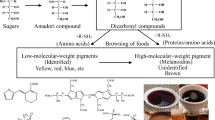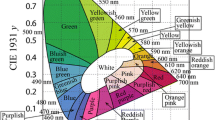Abstract
Peptidic inhibition of the enzyme tyrosinase, responsible for skin pigmentation and food browning, would be extremely useful for the food, cosmetics, and pharmaceutical industries. In order to identify novel inhibitory peptides, a library of short sequence oligopeptides was screened to reveal direct interaction with the tyrosinase. A phage displaying heptapeptide (IQSPHFF) was found to bind most strongly to tyrosinase. The inhibitory activity of the heptapeptide was evaluated using mushroom tyrosinase. The results showed that the peptide inhibited both the monophenolase and diphenolase activities of mushroom tyrosinase with IC50 values of 1.7 and 4.0 mM, respectively. The heptapeptide is thought to be a reversible competitive inhibitor of diphenolase with the inhibition constants (Ki) of 0.765 mM. To further investigate how the heptapeptide exerts its inhibitory effect, a docking study between tyrosinase and heptapeptide was performed. The simulation showed that the heptapeptide binds in the active site of the enzyme near the catalytically active Cu ions and forms hydrogen bonds with five histidine residues on the active site. Phage display technology is thus a useful approach for the screening of potential tyrosinase inhibitors and could be widely applicable to a much wider range of enzymes.








Similar content being viewed by others
References
Ubeid, A. A., Do, S., Nye, C., & Hantash, B. M. (2012). Potent low toxicity inhibition of human melanogenesis by novel indole-containing octapeptides. Biochimica et Biophysica Acta, 1820, 1481–1489.
Kwak, S. Y., Choi, H. R., Park, K. C., & Lee, Y. S. (2011). Kojic acid-amino acid amide metal complexes and their melanogenesis inhibitory activities. Journal of Peptide Science, 17, 791–797.
Lee, D. W., Kim, H. J., Choi, C. H., Shin, J. H., & Kim, E. K. (2011). Development of a protein chip to measure PKCβ activity. Applied Biochemistry and Biotechnology, 163, 803–812.
Poyedinok, N., Mykhaylova, O., Tugay, T., Tugay, A., Negriyko, A., & Dudka, I. (2015). Effect of light wavelengths and coherence on growth, enzymes activity, and melanin accumulation of liquid-cultured Inonotus obliquus (Ach.: Pers.) Pilát. Applied Biochemistry and Biotechnology, 176, 333–343.
Antonelli, A. C., Zhang, Y., Golub, L. M., Johnson, F., & Simon, S. R. (2014). Inhibition of anthrax lethal factor by curcumin and chemically modified curcumin derivatives. Journal of Enzyme Inhibition and Medicinal Chemistry, 29, 663–669.
Guo, Y. J., Pan, Z. Z., Chen, C. Q., Hu, Y. H., Liu, F. J., Shi, Y., & Chen, Q. X. (2010). Inhibitory effects of fatty acids on the activity of mushroom tyrosinase. Applied Biochemistry and Biotechnology, 162, 1564–1573.
Wu, J., Hu, X., & Ma, L. (2011). Synthesis and biological evaluation of polyhydroxy benzophenone as mushroom tyrosinase inhibitors. Journal of Enzyme Inhibition and Medicinal Chemistry, 26, 449–452.
Liu, X. X., Sun, S. Q., Wang, Y. J., Xu, W., Wang, Y. F., Park, D., & Han, H. Y. (2013). Kinetics and computational docking studies on the inhibition of tyrosinase induced by oxymatrine. Applied Biochemistry and Biotechnology, 169, 145–158.
Liao, W. C., Wu, W. H., Tsai, P. C., Wang, H. F., Liu, Y. H., & Chan, C. F. (2012). Kinetics of ergothioneine inhibition of mushroom tyrosinase. Applied Biochemistry and Biotechnology, 166, 259–267.
Tokiwa, Y., Kitagawa, M., & Raku, T. (2007). Enzymatic synthesis of arbutin undecylenic acid ester and its inhibitory effect on mushroom tyrosinase. Biotechnology Letters, 29, 481–486.
Hu, X., Wu, J. W., Wang, M., Yu, M. H., Zhao, Q. S., Wang, H. Y., & Hou, A. J. (2012). 2-Arylbenzofuran, flavonoid, and tyrosinase inhibitory constituents of Morus Yunnanensis. Journal of Natural Products, 75, 82–87.
Rho, H. S., Ahn, S. M., Lee, B. C., Kim, M. K., Ghimeray, A. K., Jin, C. W., & Cho, D. H. (2010). Changes in flavonoid content and tyrosinase inhibitory activity in kenaf leaf extract after far-infrared treatment. Bioorganic and Medicinal Chemistry Letters, 20, 7534–7536.
Rho, H. S., Lee, C. S., Ahn, S. M., Hong, Y. D., Shin, S. S., Park, Y. H., & Park, S. N. (2011). Studies on tyrosinase inhibitory and antioxidant activities of benzoic acid derivatives containing kojic acid moiety. Bulletin of the Korean Chemical Society, 32, 4411–4414.
Ha, Y. M., Uehara, Y., Park, D., Jeong, H. O., Park, J. Y., & Chung, H. Y. (2012). Synthesis and preliminary in vitro biological evaluation of 5-chloro-2-(substituted phenyl) benzo thiazole derivatives designed as novel antimelanogenesis agents. Applied Biochemistry and Biotechnology, 168, 1416–1433.
Yi, W., Wu, X., Cao, R., Song, H., & Ma, L. (2009). Biological evaluations of novel vitamin C esters as mushroom tyrosinase inhibitors and antioxidants. Food Chemistry, 117, 381–386.
Altun, M. L., Yılmaz, B. S., Orhan, I. E., & Citoglu, G. S. (2013). Assessment of cholinesterase and tyrosinase inhibitory and antioxidant effects of Hypericum perforatum L. (St. John’s wort). Industrial Crops and Products, 43, 87–92.
Chen, Y. S., Lee, S. M., Lin, C. C., Liu, C. Y., Wu, M. C., & Shi, W. L. (2013). Kinetic study on the tyrosinase and melanin formation inhibitory activities of carthamus yellow isolated from Carthamus tinctorius L. Journal of Bioscience and Bioengineering, 115, 242–245.
Wu, X., Yin, S., Zhong, J., Ding, W., Wan, J., & Xie, Z. (2012). Mushroom tyrosinase inhibitors from Aloe barbadensis miller. Fitoterapia, 83, 1706–1711.
Schurink, M., van Berkel, W. J., Wichers, H. J., & Boeriu, C. G. (2007). Novel peptides with tyrosinase inhibitory activity. Peptides, 28, 485–495.
Ubeid, A. A., Zhao, L., Wang, Y., & Hantash, B. M. (2009). Short-sequence oligopeptides with inhibitory activity against mushroom and human tyrosinase. The Journal of Investigative Dermatology, 129, 2242–2249.
Kim, H., Choi, J., Cho, J. K., Kim, S. Y., & Lee, Y. S. (2004). Solid-phase synthesis of kojic acid-tripeptides and their tyrosinase inhibitory activity, storage stability, and toxicity. Bioorganic and Medicinal Chemistry Letters, 14, 2843–2846.
Srila, W., & Yamabhai, M. (2013). Identification of amino acid residues responsible for the binding to anti-FLAG™ M2 antibody using a phage display combinatorial peptide library. Applied Biochemistry and Biotechnology, 171, 583–589.
McGonigal, K., Tanha, J., Palazov, E., Li, S., Gueorguieva-Owens, D., & Pandey, S. (2009). Isolation and functional characterization of single domain antibody modulators of caspase-3 and apoptosis. Applied Biochemistry and Biotechnology, 157, 226–236.
Zhang, W. J., Sui, Y. X., Budha, A., Zheng, J. B., Sun, X. J., Hou, Y. C., & Lu, S. Y. (2012). Affinity peptide developed by phage display selection for targeting gastric cancer. World Journal of Gastroenterology, 18, 2053–2060.
Ebrahimizadeh, W., Gargari, S. L. M. M., Javidan, Z., & Rajabibazl, M. (2015). Production of novel VHH nanobody inhibiting angiogenesis by targeting binding site of VEGF. Applied Biochemistry and Biotechnology, 176, 1985–1995.
Gazarian, K., Rowlay, M., Gazarian, T., Buchelli, J. E. V., & Gonzáles, M. H. (2012). Mimotope peptides selected from phage display combinatorial library by serum antibodies of pigs experimentally infected with Taenia solium as leads to developing diagnostic antigens for human neurocysticercosis. Peptides, 38, 381–388.
Dong, J., Otsuki, T., Kato, T., Kohsaka, T., Ike, K., & Park, E. Y. (2013). Development of two murine antibodies against Neospora caninum using phage display technology and application on the detection of N. caninum. PloS One, 8, e53264.
Rao, S. S., Mohan, K. V. K., Gao, Y., & Atreya, C. D. (2013). Identification and evaluation of a novel peptide binding to the cell surface of Staphylococcus aureus. Microbiological Research, 168, 106–112.
Meyer, T., Schirrmann, T., Frenzel, A., Miethe, S., Stratmann-Selke, J., Gerlach, G. F., & Hust, M. (2012). Identification of immunogenic proteins and generation of antibodies against salmonella typhimurium using phage display. BMC Biotechnology, 12, 29.
Gagic, D., Wen, W., Collett, M. A., & Rakonjac, J. (2013). Unique secreted-surface protein complex of Lactobacillus rhamnosus, identified by phage display. Microbiologyopen, 2, 1–17.
Casañola-Martín, G. M., Marrero-Ponce, Y., Khan, M. T. H., Ather, A., Sultan, S., Torrens, F., & Rotondo, R. (2007). TOMOCOMD-CARDD descriptors-based virtual screening of tyrosinase inhibitors: evaluation of different classification model combinations using bond-based linear indices. Bioorganic and Medicinal Chemistry, 15, 1483–1503.
Li, S. B., Xue, Y., Lv, X. Y., Nie, H. L., Zhu, L. M., Zhang, H. T., & Zhou, L. M. (2009). In vitro effect of ozagrel on mushroom tyrosinase. The Protein Journal, 28, 182–188.
Liu, L., Bai, S., Yang, H., Li, S., Quan, J., Zhu, L., & Nie, H. (2016). Controlled release from thermo-sensitive PNVCL-co-MAA electrospun nanofibers: the effects of hydrophilicity/hydrophobicity of a drug. Materials Science and Engineering C, 67, 581–589.
Schrödinger, L. L. C. (2009). Glide, version 5.5 [J]. Schrödinger, LLC, New York, NY.
Schrödinger, L. L. C. (2009). Maestro, version 9.0 [J]. Schrödinger, LLC, New York, NY.
Schrödinger, L. L. C. (2009). Ligprep, version 2.3 [J]. Schrödinger, LLC, New York, NY.
Schrödinger, L. L. C. (2010). The PyMOL molecular graphics system, version 1.3 [J]. Schrödinger, LLC, New York, NY.
Li, S. B., Nie, H. L., Zhang, H. T., Xue, Y., Chris, B., & Zhu, L. M. (2010). Inhibitory kinetics of a trifluoromethyl-containing 1,2,3-triazole derivative on mushroom tyrosinase activity. Acta Physico-Chimica Sinica, 26, 215–220.
Delogu, G., Podda, G., Corda, M., Fadda, M. B., Fais, A., & Era, B. (2010). Synthesis and biological evaluation of a novel series of bis-salicylaldehydes as mushroom tyrosinase inhibitors. Bioorganic and Medicinal Chemistry Letters, 20, 6138–6140.
Acknowledgments
This work was financially supported by the Shanghai Natural Science Foundation (14ZR1401300), the Shanghai Pujiang Program (16PJD007) and the Fundamental Research Funds for the Central Universities (2232015D3-15).
Author information
Authors and Affiliations
Corresponding author
Additional information
Highlights
• A novel heptapeptide with tyrosinase inhibitory activity was identified.
• A phage display technology was used in screening an enzyme inhibitor.
• A docking study between tyrosinase and heptapeptide was performed.
Rights and permissions
About this article
Cite this article
Nie, H., Liu, L., Yang, H. et al. A Novel Heptapeptide with Tyrosinase Inhibitory Activity Identified from a Phage Display Library. Appl Biochem Biotechnol 181, 219–232 (2017). https://doi.org/10.1007/s12010-016-2208-3
Received:
Accepted:
Published:
Issue Date:
DOI: https://doi.org/10.1007/s12010-016-2208-3




